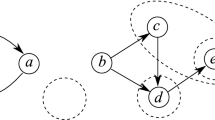Abstract
This paper is about the concept of semantically closed languages. Roughly speaking, those are languages which can name their own sentences and apply to them semantic predicates, such as the truth or satisfaction predicates. Hence, they are “self-referential languages,” in the sense that they are capable of producing sentences about themselves or other sentences in the same language. In section one, we introduce the concept informally; in section two, we provide the formal definition of first-order semantically closed languages, which is the Tarskian definition with some technical modifications. Then, we construct a semantic for this kind of language, and prove that the language is indeed semantically closed (according to Definition 1). Finally, we discuss whether the logic underlying the construction is classical, and future goals of this research.
Similar content being viewed by others
References
Aristotle, Metaphysics, translation by C.D.C. Reeve, Hackett Publishing Company, 2016 (Original written sometime between 370 and 322 BC).
Herzberger, H. G., The truth-conditional consistency of natural languages, The Journal of Philosophy 64(2):29–35, 1967.
Martin, R. L., Are natural languages universal? Synthese 32:271–291, 1976.
Priest, G., In Contradiction, Oxford University Press, 2006.
Priest, G., Semantic closure, Studia Logica 43(1–2):117–129, 1984.
Priest, G., Inconsistent models of arithmetic part I: finite models, Journal of Philosophical Logic 26(2):223–235, 1997.
Priest, G., Inconsistent models of arithmetic part II: the general case, The Journal of Symbolic Logic 65(4):1519–1529, 2000.
Shoenfield, J. R., Mathematical Logic, Addison-Wesley Publishing Company, 1967.
Tarski, A., The concept of truth in formalized languages, Logic, Semantics, Metamathematics 2(152–278):152, 1936.
Author information
Authors and Affiliations
Corresponding author
Additional information
Publisher's Note
Springer Nature remains neutral with regard to jurisdictional claims in published maps and institutional affiliations.
Special Issue: Contemporary Logic in Brazil
Edited by Edward H. Haeusler, Ciro Russo, and Gisele Secco.
Rights and permissions
Springer Nature or its licensor (e.g. a society or other partner) holds exclusive rights to this article under a publishing agreement with the author(s) or other rightsholder(s); author self-archiving of the accepted manuscript version of this article is solely governed by the terms of such publishing agreement and applicable law.
About this article
Cite this article
Abrahão, F.B., de Souza, E.G. On a First-Order Bi-Sorted Semantically Closed Language. Stud Logica (2024). https://doi.org/10.1007/s11225-024-10104-6
Published:
DOI: https://doi.org/10.1007/s11225-024-10104-6



